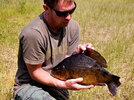Huanzhou Zhu
Senior Member
Speaking of non-native fish, how many of you are not putting zander back,
Follow along with the video below to see how to install our site as a web app on your home screen.
Note: This feature may not be available in some browsers.
The minute Zander start hybridising with pike or perch I’ll take your point Jeff.Speaking of non-native fish, how many of you are not putting zander back,
I recall Martin Bowler making the point in the angling press a good few years back that the Marsh Farm/Johnsons crucians (elongated/low back) and the Yateley crucians (high back) he was catching (which of course included his once record fish) were physically very different. I think he even went as far as saying they were a different species, which was wrong of course. He copped a bit of flack because it came across as sour grapes, which I don't think it was because he isn't that type, but at the time the low-high back distinction had never really been flagged up. The DNA tests proved that are both strains bona-fide crucians, and it seems that just like carp, different strains with differing shapes exist, which makes perfect sense of course.According to Peter Rolfe in his excellent book on Crucians "Crock of Gold" Prussian carp used to be used to describe a multitude of similar but different fish to Crucians. Such as Brown Goldfish and Crucian crosses. The thing about Crucians is they can exist in high and low back forms and readily hybridise with carp & goldfish, so knowing what you have caught can be hard. Amazing fish Joe I'm jealous
Yes your quite right. There is a school of thought which suggests they are native based on the distribution of other species which were present in the British Isles before the land bridge disappeared. Then there is the view that were at least present since the Roman times which seems to be based on the discovery of a single crucian bone which seems a bit tenuous to me. The theory that they were brought in during the middle ages seems the most credible.By the way there's some debate if Crucians are actually native to the UK. They may well have been imported in the middle ages alongside brown goldfish as another fish to breed for food (alongside carp) and also for ornamentation.
This has been my moto for some years now. A truly balanced fishery minus the usual fill-it-in with carp, is like hens teeth now. Btw, you need a few pike and perch to keep it fully in balance.Like the poor old crucian really needs another existential threat…..
And then the general apathy of most angling clubs towards them.
I once suggested to one of the committee members of one of my clubs that they should consider removing the carp from one of their little pleasure fisheries and making a haven for Crucians, Tench, Rudd, roach. Make it like a classic old summer fishery…might even attract a few new members who see beyond carp.….might help just a little to support the long term survival of a few rapidly diminishing fish species.
He looked at me like I was an escaped lunatic and dismissed me with “Remove carp, you say? Yeah, that’s a stupid idea.”
Speaking of non-native fish, how many of you are not putting zander back,
Life finds a way.I think the real question for me is, has any invasive fish species ever been stopped (ignoring any that have been unsuccessful due to the climate not being suitable or unsuitable for rivers as a habitat).
I ask as in South Korea the Crucian is the most fished species either for pleasure or food. In 1963 Black Bass (Large Mouth Bass) were introduced as a source of protein or escaped from an army base, depending on your source. They escaped/were released into the river system and no matter how hard the fishermen and government tried, they spread at an alarming rate, at one point over 70% of the native fish stock were wiped out. Now balance has been found and all affected stocks recovered (recent dwindling unrelated, and likely the same reason as every other nation imo - pollution).
You cannot imagine the effort put in by the fishermen there to stop the spread, but with no success. Even now you can see the carcasses of the BB around all the reservoirs and rivers still being left to die by fishermen (usually in their 40s or older, as the new generation of lure fisherman love them).
Considering how widespread the Zander find themselves in our waters, does anyone truly believe the “invasion” can be stopped. It is even believed by some in Korea that the attempts to stop the spread increased the time it took for balance to be found.
Always interested in people's view on this, as they often differ greatly.
I really enjoyed fishing the same place as you, Joe. Some of them are just the most ancient looking things, though I guess being buried in peat for decades would have that effect! The potential of hundreds/thousands of other unfished and inaccessible waters in Scandinavia will probably never be realised.Crucians are amazing species, remarkably tough and resilient fish.
Fished for them in remote forests lakes in Sweden where they are able to survive in lakes that are frozen over for more than 6 months of the year. They bury themselves in the anaerobic peaty silt for months on end, producing ethanol to protect against the icy temps. Truly remarkable fish.
I'm told some of the crucians I was catching were over 70 years old. No doubting the origin of these old girls.



